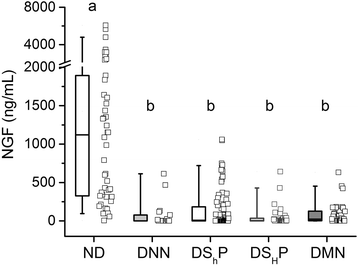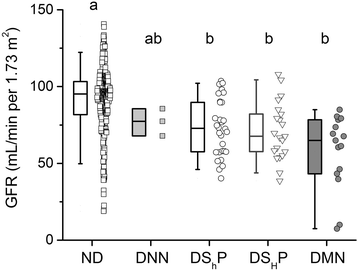Neuropathy-specific alterations in a Mexican population of diabetic patients
- PMID: 28841856
- PMCID: PMC6389277
- DOI: 10.1186/s12883-017-0939-6
Neuropathy-specific alterations in a Mexican population of diabetic patients
Abstract
Background: Neuropathy is one of the major complications of type 2 diabetes mellitus. Our first aim was to determine the clinical characteristics of a population of diabetic patients with different types of neuropathy. Our next goal was to characterize the cytokine profile (IL-6 and IL-10), nerve growth factor (NGF) and circulating cell-adhesion molecules in these patients. Finally, we aimed to compare the renal function among the groups of neuropathic patients.
Methods: In a cross-sectional study, we included 217 diabetic patients classified in three groups: sensory polyneuropathy with hypoesthesia (DShP) or hyperesthesia (DSHP), and motor neuropathy (DMN). Two control groups were included: one of 26 diabetic non-neuropathic patients (DNN), and the other of 375 non-diabetic (ND) healthy subjects. The participants were attending to the Mexican Institute of Social Security.
Results: The circulating levels of NGF were significantly lower in diabetic patients, compared to healthy subjects. The range of IL-6 and IL-10 levels in neuropathic patients was higher than the control groups; however, several samples yielded null measurements. Neuropathic patients also showed increased circulating levels of the adhesion molecules ICAM, VCAM, and E-Selectin, compared to the ND group. Moreover, neuropathic patients showed reduced glomerular filtration rates compared to healthy subjects (82-103 ml/min per 1.73 m2, data as range from 25th-75th percentiles), especially in the group with DMN (45-76 ml/min per 1.73 m2).
Conclusions: Some particular alterations in neuropathic patients included -but were not limited to- changes in circulating NGF, cell adhesion molecules, inflammation, and the worsening of the renal function. This study supports the need for further clinical surveillance and interventions considering a neuropathy-related basis.
Keywords: Cardiovascular complications; Cell adhesion molecules; Diabetic complications; Dyslipidemia; Inflammation; Insulin resistance; Neuropathy; Neurotrophin; Renal dysfunction; Type 2 diabetes mellitus.
Conflict of interest statement
Ethics approval and consent to participate
Prior to the study, we obtained ethical clearance by the Ethics and Research Institutional Review Boards of the Mexican Institute of Social Security (protocol approved under the number 2004–3601-002 for the National Commission for Research), at the facility Unidad Médica de Alta Especialidad (UMAE) “Bernardo Sepúlveda” of the hospital Centro Médico Nacional “Siglo XXI” in Mexico City.
Written informed consent to participate was obtained from patients before their enlistment in the study.
Consent for publication
Informed consent allowing the publication of the conclusions derived from this study was also obtained from patients.
Competing interests
The authors declare that they have no competing interests.
Publisher’s Note
Springer Nature remains neutral with regard to jurisdictional claims in published maps and institutional affiliations.
Figures




Similar articles
-
Cytokine Levels in Neural Pain in Leprosy.Front Immunol. 2020 Jan 24;11:23. doi: 10.3389/fimmu.2020.00023. eCollection 2020. Front Immunol. 2020. PMID: 32038662 Free PMC article.
-
Low serum levels of nerve growth factor in diabetic neuropathy.Acta Neurol Scand. 1990 May;81(5):402-6. doi: 10.1111/j.1600-0404.1990.tb00984.x. Acta Neurol Scand. 1990. PMID: 2375241
-
Nerve growth factor and expression of its receptors in patients with diabetic neuropathy.Diabet Med. 2009 Dec;26(12):1228-34. doi: 10.1111/j.1464-5491.2009.02856.x. Diabet Med. 2009. PMID: 20002474
-
[Diabetic somatic polyneuropathy. Pathogenesis, clinical manifestations and therapeutic concepts].Fortschr Neurol Psychiatr. 2000 Jun;68(6):278-88. doi: 10.1055/s-2000-11535. Fortschr Neurol Psychiatr. 2000. PMID: 10923253 Review. German.
-
Mechanisms of disease: role of neurotrophins in diabetes and diabetic neuropathy.Handb Clin Neurol. 2014;126:443-60. doi: 10.1016/B978-0-444-53480-4.00032-1. Handb Clin Neurol. 2014. PMID: 25410238 Review.
Cited by
-
The association of cell adhesion molecules and selectins (VCAM-1, ICAM-1, E-selectin, L-selectin, and P-selectin) with microvascular complications in patients with type 2 diabetes: A follow-up study.Front Endocrinol (Lausanne). 2023 Feb 9;14:1072288. doi: 10.3389/fendo.2023.1072288. eCollection 2023. Front Endocrinol (Lausanne). 2023. PMID: 36843591 Free PMC article.
-
The role of novel inflammation-associated biomarkers in diabetic peripheral neuropathy.Metabol Open. 2024 Nov 1;24:100328. doi: 10.1016/j.metop.2024.100328. eCollection 2024 Dec. Metabol Open. 2024. PMID: 39559514 Free PMC article. Review.
-
Curcumin ameliorates pyroptosis in diabetic seminal vesicles by upregulating TRPV6.Andrology. 2025 Mar;13(3):624-636. doi: 10.1111/andr.13687. Epub 2024 Jul 5. Andrology. 2025. PMID: 38966878 Free PMC article.
References
MeSH terms
Substances
LinkOut - more resources
Full Text Sources
Other Literature Sources
Medical

